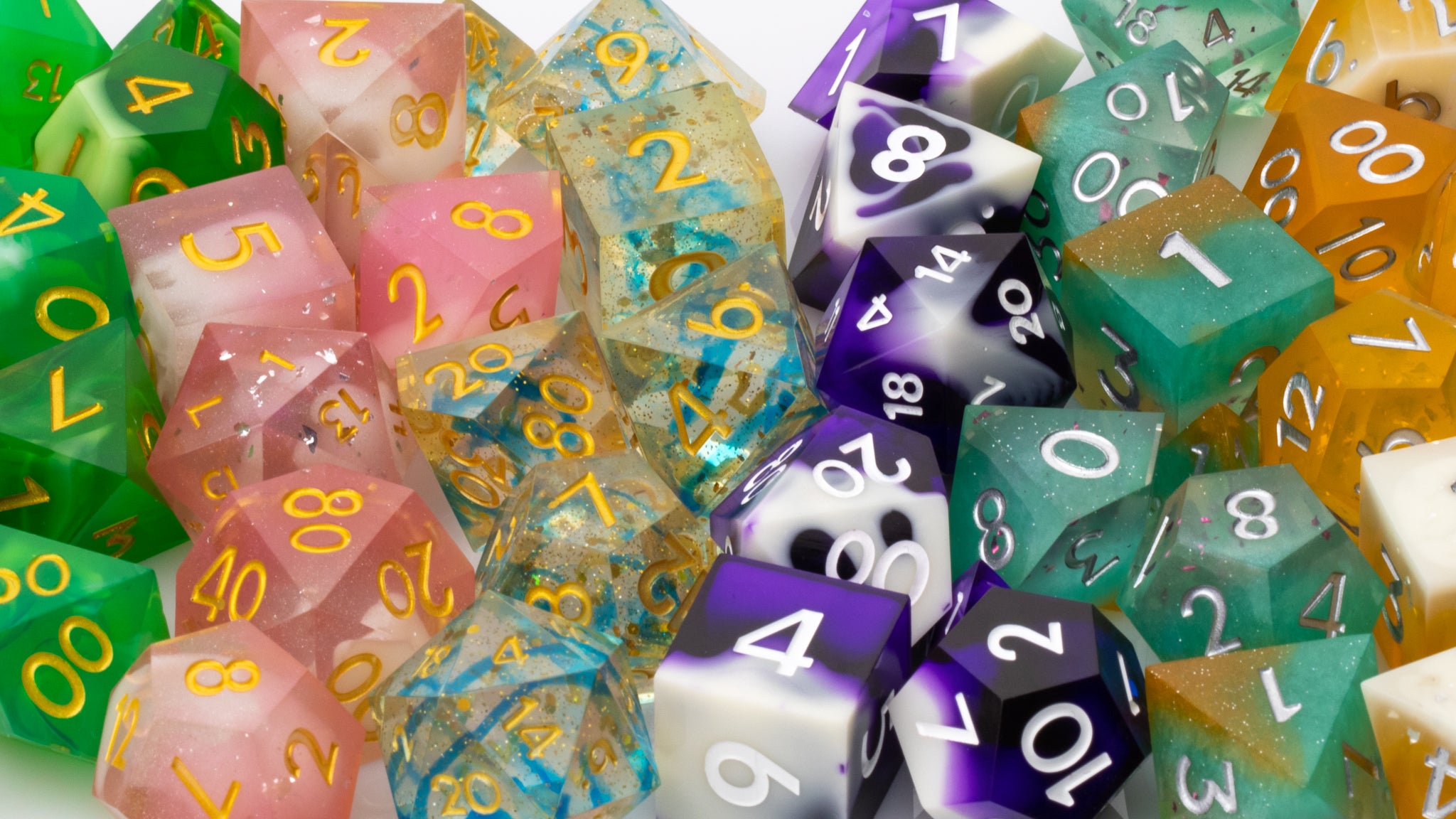If you are new to tabletop RPGs you might find yourself thinking, “What’s with all of these dice?” I remember seeing a D20 for the first time. Someone told me it was a die, and I thought they had to be lying. What weird and wonderful world had I fallen into where dice can be something other than a cube?
Little did I know that polyhedral dice and the humble D20 have a long and storied history. They're nearly as old as civilization itself!
And if you're starting out with DND, the D20 is just the start! If you're unfamiliar, all of these weird shaped dice can be intimidating, but it doesn’t have to be.
What Dice Do I Need for DND?
The standard for modern D&D is the 7 piece dice set. This should include a 20-sided die (D20), a 12-sided die (D12), two 10-sided dice (D1 & D00—also called D% or percentile die), an 8-sided die (D8), a 6-sided die (D6), and a 4-sided die (D4).
You might wonder why you need all of these different dice. And the fact is that you won’t use all your dice every game, but they all have their uses. What you don't want to happen is you need a particular die to determine an outcome in the game and not have it! Let's run the list from most sides to least!
What is a D20?
The D20 is an icosahedron or 20 sided die. DND uses the D20 system of gameplay. Most game mechanics, meaning anything that your character attempts at the table will involve rolling a D20. So the D20 is the workhorse of your dice collection! Anytime you make an attack, check an ability, or attempt to do an action in the game that requires a check (usually a number between 1 and 20 that you will have to beat with your roll to succeed) you will roll that D20.
Swinging your sword at the troll? Roll a D20. Casting a spell at the Gelatinous Cube? Roll a D20. Need to pick a lock or try to force a door open? You guessed it.. roll a D20.
Roll higher than your enemy’s Armor Class (AC) or the problem’s Difficulty Class (DC) and you succeed!
What is a D12?
The D12 is a dodecahedron or 12-sided die. The humble D12 may be the least used of the standard 7-piece dice set. At least it is at my table. As with a lot of the other dice in the standard set, it is mostly used to calculate damage after an attack has landed or “hit.” So in normal tabletop game play, you would roll your D20 to attack, then depending on your weapon or spell (think big-hitter weapons like great axes or lance or spells like Poison Spray or Witch Bolt) you would roll a D12 to calculate the damage your attack delivers. The higher your roll the better, obviously! Certain character classes (again think big-hitters like the barbarian) use the D12 to calculate Hit Points (HP). HP is essentially health or life. It's a number showing how much damage you can take before you're knocked unconcious or die!
What is a D10?
The D00, also called the D% or percentile die, is mainly used in combination with the D10 when you need a percentile check. This is used to determine results on certain tables in the game or for determining a spell effect. You would roll both the D10 and the D00, then combine those 2 results to get a number between 1 and 100. An example of this would be a Critical Miss table. This is a fun game mechanic, where if you roll a natural 1 on your D20 while attacking, you then have to roll your percentile dice to determine a random (usually bad but funny) effect. Technically you can get a percentile by rolling a D10 twice (in fact that's how it used to be done), but I personally think it’s more fun this way. And, y’know, more dice!
What is a D8?
The D8 is an octahedron or 8-sided die. The D8 is also used to calculate damage and spell effects (see a pattern here?). It's used to calcuate damange for more mid-range weapons like a greatclub, light crossbow, morningstar, or longbow. Spells that use the D8 include Chill Touch, Sacred Flame, Thunderwave, and Cure Wounds. It is also the Hit Die for bards, clerics, druids, monks, rogues, and warlocks.
What is a D6?
The D6 or cube is a 6-sided die. This is what most people (normies) think of when they think of dice. It's the shape you pulled out of your old Monopoly set or that took your money at the craps table. The D6 is another work horse in your DND dice set. It is the damage die for a wide variety of weapons and spell effects. Weapons that use a D6 to calcuate damage include the handaxe, mace, spear, shortbow, shortsword, trident, etc. Spell effects that use the D6 include Acid Splash, Frostbite, Infestation, Thorn Whip, etc. Several spells use multiple D6's, such as Burning Hands, Dissonant Whispers, Guiding Bolt, and the perrenial favorite--Fireball. It is the Hit Die for your physically weaker classes like sorcerer or wizard. It is also the die you use if you are rolling for your character’s Ability Scores. You will use multiple rolls of these to determine your character’s Strength, Dexterity, Constitution, Intelligence, Wisdom, and Charisma. If you love playing a sneaky rogue, you’ll use a D6 (or several) to calculate sneak attack damage. And there are few things as fun as rolling a big handful of 8D6 to calculate damage from a fireball spell.
What is a D4?
The D4 or tetrahedron is a 4-sided die. Affectionately known as the caltrop for its pyramidal shape and its ability to neatly puncture a bare foot if unseen on the floor. The D4 is also used to (say it with me) calculate damage and spell effects. The weapons that use the D4 for damage calculations are smaller and obviously do less damage. These include the club, dagger, dart, or whip. Spells that use the D4 include Vicious Mockery, Guidance, and Divine Favor. Some more potent spells that use multiple D4s include Cloud of Daggers and Melf's Acid Arrow. If you’ve never used one before, you’ll quickly find they don’t roll especially well. The best move is more of a flipping toss to get a random number. Because of this some people don’t love the D4, and there are some new designs that attempt to make it more “roller” friendly. So far, here at Libris Arcana, we stick to the classic design.
What type of dice set should I buy for my first game of DND?
There are so many options! Here at Libris Arcana, we particularly love resin dice for their shine and feel in the hand. You could go more unique with a handmade or metal set. And if you want to get way out there, you could shop for a beautiful and unique set in gemstone, glass, wood, or even bone!
But... for your very first game, I'd recommend grabbing some cheap, off the shelf acrylic dice. You can easily find them in any hobby shop or online for less than $10. They'll get you through the first game or even the first campaign. And you can always come back and see us when you're ready to upgrade to some beatiful, click-clacky math rocks!
How many sets of DND Dice do I need?
You really only need one 7-piece set of dice to play DND (I shudder to think of it, but you could even get away with using an digital dice roller!) Now can get annoying if you need to roll multiples of the same die over and over to generate your ability score or for damage or spell effects, but it will totally get the job done.
If you’re like most, however, you’ll find you want more than one set. And if you’re like some of us, you will want all of the sets!
In which case you might consider a dice subscription! It gets you early access to our unique, limited-edition resin dice sets, and it’s super simple to pause or cancel any time. We announce each set with pictures and a description prior to shipping on Dice Day, so you could even turn it on or off each month depending on if you like the set that’s coming out.









0 comments